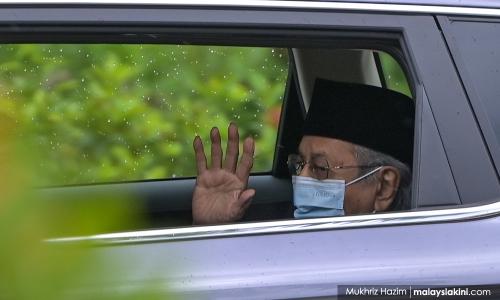LETTER | NOC 2.0 - It’s Mahathir’s formula 2.0
LETTER | To be honest, Jason Loh’s “Let's get it straight on National Operations Council” wasn’t an easy read.
The shortcomings are mine. But this much is clear from Jason - the Yang di-Pertuan Agong (YDPA) is a constitutional monarch. He acts on advice [Article 40(1) of the Federal Constitution].
Since the YDPA’s proclamation of emergency is in the exercise of his majesty’s function under Article 150(1) of the Federal Constitution, he must therefore act “in accordance with the advice of the cabinet or of a minister acting under the general authority of the cabinet.”
In the case of Teh Cheng Poh v Public Prosecutor [1979], Lord Diplock in the Privy Council – then the country’s apex court – affirmed the position that in all matters where the YDPA must be satisfied, it is in reality the satisfaction of the cabinet.
And in all practicalities, it is the satisfaction of the prime minister.
Similarly, since the YDPA’s promulgation of emergency ordinances is made under the Federal Constitution – currently Article 150(2B) – his majesty must act on advice.
So, let’s get it straight on the 1969 emergency. The emergency was proclaimed by the YDPA on May 15, 1969 vide PU (A) 145/69. The proclamation was explained by the late Tunku Abdul Rahman:
“It was necessary for me to advise his majesty to proclaim a state of emergency throughout the country as there was no other way of dealing effectively with the current situation.” [See Tunku Abdul Rahman, May 13: Before & After (1969) cited by Cyrus Das in his doctoral thesis “Emergency Powers and Parliamentary Government in Malaysia: Constitutionalism in a New Democracy” (1994)].
The proclamation was followed by the promulgation of the Emergency (Essential Powers) Ordinance No. 1 of 1969 on the same day. It was this ordinance that conferred the power to govern by emergency regulations upon the executive or government. This ordinance did not establish the National Operation Council (NOC) or Majlis Gerakan Negara.
It was the Emergency (Essential Powers) Ordinance No. 2 of 1969 – promulgated the next day. Cyrus Das explained:
“By another law made the next day, called the Emergency (Essential Powers) ordinance No. 2 of 1969, there was appointed a special officer-called the Director of Operations, who was to be assisted by a newly created special body, called the National Operations Council to administer the state of emergency. Section 2(1) of the said ordinance declared that the executive authority of the federation was to be delegated by the Yang di-Pertuan Agong to the director of operations who was nevertheless to act in accordance with the advice of the prime minister. These newly created appointments and bodies were a special feature of the 1969 Emergency.”
The person appointed as director of operations was the then deputy prime minister, the late Tun Abdul Razak.
Cyrus Das has an interesting account of the 1969 Emergency: the decision to declare the state of emergency “was taken by the then Prime Minister Tunku Abdul Rahman personally. The riots had broken out even before Tunku could constitute his new cabinet… But it would appear that he had at least the concurrence of the then deputy prime minister, Tun Abdul Razak.”
Now, if it was the Tunku who had decided on the state of emergency, it was Razak who presented the emergency ordinances to the YDPA for his majesty’s consideration and approval.
Perhaps one may have been inspired that other than a prime minister, someone else may present to the YDPA for the establishment of a NOC-like body, if not a NOC 2.0. But, as stated above, the YDPA must act on advice, which is the advice of the cabinet or of a minister acting under the general authority of the cabinet.
As Cyrus Das suggested, Razak had the concurrence of the caretaker prime minister, i.e. the Tunku.
Now, a NOC-like solution was also proposed before the 1977 Kelantan Emergency which was confined to Kelantan and brought about by political squabbles in the State, like the 1966 Sarawak Emergency. Before the proclamation, the then prime minister, the late Hussein Onn had tasked his deputy, Dr Mahathir Mohamad to find a solution to the political squabbles.
A “NOC-style government” in Kelantan was proposed. The then opposition leader, Lim Kit Siang, called it “the Mahathir formula” in the parliamentary debates at that time (November 8, 1977). According to Cyrus Das, it was “the rejection of this formula in discussions with the prime minister on November 7 that led to the declaration of an emergency the next day.”
So, it is history repeating itself, as Mahathir himself revealed that he proposed the setting up of a NOC-style government – NOC 2.0 if you like.
It must be Mahathir’s formula 2.0. But as rightly responded to by the YDPA, in order to set up the NOC the proposal must come from the government.
Simply put, the government advises the YDPA. His majesty acts in accordance with the advice.
It may be Mahathir's formula 2.0, but it must come from the government - in reality the prime minister.
The views expressed here are those of the author/contributor and do not necessarily represent the views of Malaysiakini.
RM12.50 / month
- Unlimited access to award-winning journalism
- Comment and share your opinions on all our articles
- Gift interesting stories to your friends
- Tax deductable
